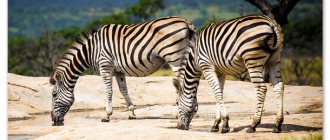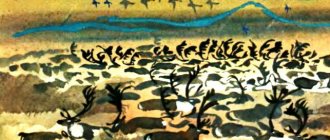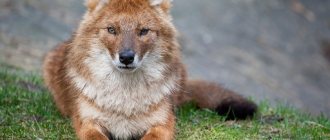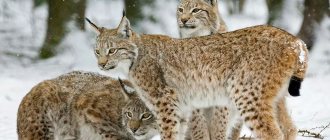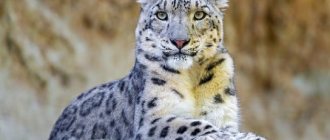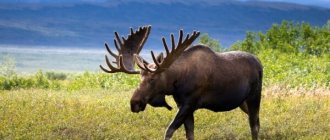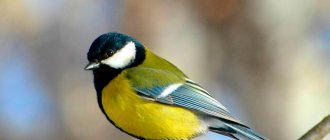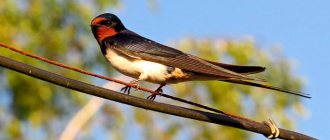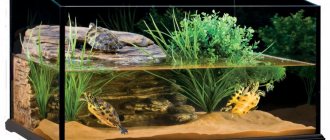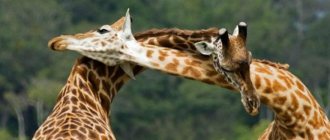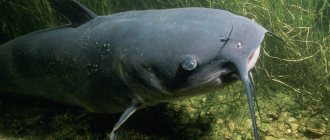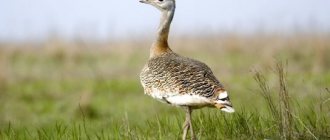- Reports and messages
- Animals
- Kangaroo
The kangaroo is the national symbol of Australia; this amazing animal is even depicted on the Australian coat of arms, since, thanks to its large tail and the special structure of its hind legs, it can only move forward.
Thus, this animal is a symbol of progress. Kangaroo belongs to the family of marsupial mammals. On the stomach of females there is a special pouch for the young, which really looks like a bag. The baby kangaroo is born underdeveloped, no more than 3 centimeters in size, then it crawls into the pouch, where it stays there for 6-8 months until it grows and gets stronger. Then the cub lives near its mother for about another year before it begins independent life. In nature, kangaroos live from 6 to 12 years; in captivity they can live up to 20 years. This is an exclusively herbivore, and also drinks very little - in dry times it can go without water for up to 5 months!
An adult kangaroo of large species weighs up to 80 kg. Height is about 1.5 meters, sometimes 2 meters. The jump reaches 13 meters in length and 3 meters in height. Kangaroos can reach speeds of up to 60 km/h. The kangaroo's tail is long and powerful at the base, helping to maintain balance when jumping. Kangaroos have grayish, red or reddish fur, matching the color of their habitat. Kangaroos' ears are quite large, very mobile, and sensitive to catch the slightest sounds. The front paws, compared to the hind paws, look awkwardly small. With them, a kangaroo can dig food from the ground (tubers and roots), and in a moment of danger it can “box” with the enemy. There are strong claws on the front and hind legs. Kangaroos found in the wild of Australia are very curious, not afraid of humans, but also do not attack without reason. An angry or frightened kangaroo can, leaning on its tail, inflict a very strong (sometimes fatal) blow on its opponent with its hind legs.
The kangaroo is endemic to Australia, that is, an animal that lives only on this continent.
Appearance
The body size of an adult male is one and a half meters, not counting the tail, which reaches another meter in length. The animal weighs 80–85 kilograms. The fur is short and thick, brownish-red in color.
Powerful hind legs and a large, heavy tail allow the kangaroo to jump superbly. In case of danger, in one jump he can cover a distance of up to 12 meters in length and up to 3 meters in height. If it is necessary to fight back, the animal suddenly leans on its own tail, and with its freed hind legs it painfully hits the enemy.
The front clawed legs are excellent for digging up edible roots. Females have a convenient pouch - a deep fold of skin on the abdomen, in which the mother carries the kangaroo.
Description
Depending on the species, representatives of the family have a length from 25 cm (plus 45 cm - tail) to 1.6 m (tail - 1 m), and weigh from 18 to 100 kg. The largest individual is considered to be the resident of the Australian continent - the great red kangaroo, and the heaviest is the eastern gray kangaroo. The fur of marsupials is soft, thick, and can be gray, black, red and their shades.
Koalas are the original representatives of the living world of Australia119194.811
The kangaroo is an interesting animal because its upper part is poorly developed. The head is small, the muzzle can be either long or short. The shoulders are narrow, the front legs are short, weak, hairless, have five fingers, but are armed with very sharp claws. The fingers are very mobile and the animal uses them for grasping, feeding, and combing fur.
But the lower part of the body is developed: the hind legs, a long thick tail, the hips are very strong, the foot has four toes, while the second and third are connected by a membrane, the fourth has a strong claw.
This structure makes it possible to successfully defend itself using powerful blows with its hind legs, and move quickly (in this case, the tail replaces the marsupial’s steering wheel). These animals are unable to move backwards; their tail and the shape of their hind legs do not allow them to do so.
Lifestyle
Kangaroos forage at night and during the day they rest in burrows or grass nests. They live in groups of 10–12 individuals. At the head of a small herd is a male, he has several females and small cubs. The leader is very jealous - he strictly ensures that other males do not enter his territory. Otherwise, it ends in a serious fight.
During sweltering heat, they try to move less, breathe frequently, open their mouths wide and lick their paws. If there is no way to hide in the shade from the scorching sun, they dig shallow holes in the sand.
Kangaroo animals eat plant foods. In addition to steppe grass, they love to find cereals, roots and tubers in pastures and homesteads, which causes significant harm to Australian farmers.
Popular message topics
- Spoons - a musical instrument
Spoons are one of the most famous and most ancient percussion instruments belonging to the Slavs. At first glance, they are not much different from ordinary wooden table spoons, and their use as musical - The most unusual animal
The most amazing animal is the platypus. If you look at it for the first time, it will seem that it has absorbed several parts of other animals at once. When it was discovered in the 18th century on the coast of eastern Australia, - Raven's Eye
The forest is rich in many beautiful and wonderful plants, and the Raven's Eye is no exception. This plant has been known since ancient times. People firmly believed that if you sew the berries of this plant into your clothes, it will help protect you from the evil spell of the evil eye.
Enemies
In the wild, the red kangaroo has few enemies: dingoes, foxes and birds of prey. If necessary, the marsupial can perfectly stand up for itself, using fighting techniques with the help of its hind legs. They successfully escape, reaching speeds of up to 60 kilometers per hour.
The main enemy of the kangaroo is man. Farmers and livestock breeders use various methods to combat pesky animals that eat pastures. The Australian red kangaroo is of great interest to hunters - its dietary meat is rich in proteins and contains only 2% fat. The skin is used to make clothes, shoes and other products.
The arrival of the baby
Mother kangaroos have babies every year. As soon as they are born, they climb into the pouch themselves and live there for 8 months, feeding on their mother’s milk. After all, a small cub is born completely naked. And its size is no larger than a peanut. It takes a lot of strength to grow and become as tall as an adult man. Mom protects her son or daughter, cleans and closes the bag when it’s cold or raining. If there are kangaroos of different ages in the bag, there will be separate milk for each of them. Various fat contents, just like in the store.
Progress of the lesson:
I. Geographical location and natural areas of Australia.
— Guys, you and I have traveled a lot around our country. Remember where we went? (at the North Pole, in the tundra, taiga, mixed forest zone)
. And today we will go beyond Russia, to Australia. It is very easy to find on the map. When depicting it on the map, they used a lot of yellow and green colors.
— What do these colors on the map mean ? (desert and forests)
. Right! Let's look at the globe and then at the map of the territory of Australia.
— Australia is the smallest and driest continent on the planet, which is located in the eastern and southern hemispheres, washed by the seas of the Indian and Pacific Oceans, and is called the fifth continent.
There is little precipitation there, so deserts predominate, but tropical rainforests grow along the coast, where it rains more often.
Inland they are replaced by light eucalyptus forests; the leaves and bark of eucalyptus trees are rich in essential oils, which are used in medicine and technology.
II. Presentation “Travel to Australia”
.
Only in Australia can you find oviparous mammals: the platypus and the echidna.
There are many birds in Australia. The largest of them is the Emu ostrich, the most beautiful are the birds of paradise, the funniest are the Cockatoo parrots, and budgies fly in huge flocks.
There are no large deep rivers in Australia. Many rivers periodically dry up - they are called "cries"
(
"streams"
). Droughts with forest fires after heavy rains give way to devastating floods.
In the depths of Australia there are almost all types of minerals: gold, silver, copper and iron ores, coal and bauxite, uranium, aluminum. Much of this wealth is exported to other countries. The most important branch of the economy is sheep breeding; sheep wool and cheese go to many countries in Europe, Asia and America.
The mainland of Australia is occupied by one state - Australia, the capital of which is the city of Canberra, which means “meeting place”
. The Australian mainland was settled relatively recently, and therefore the country is not rich in ancient monuments.
The symbol of Australia is the kangaroo and the emu , which is why these animals are depicted on the coat of arms of Australia.
In 1988, Australia celebrated its 200th anniversary. The first European ship touched the shores of Australia in the 17th century, among the passengers were Dutch and English, as well as several hundred convicts.
The convicts began to settle on the mainland, thereby pushing aside the indigenous inhabitants of Australia - the Aborigines. Outwardly they differ from Europeans. The Aborigines are good hunters and fishermen, they invented the boomerang, they are very musical and skillfully perform national dances.
Australians do not have a national costume, they wear European clothes.
Modern Australians love sports, the most popular being swimming, as well as rowing, sailing regattas, tennis, auto racing, rugby, and golf. Horse riding is popular.
III. Phys. a minute (guessing riddles and depicting riddles in motion)
.
1. A funny bear cub lives ,
He chews eucalyptus leaves day and night. (koala)
2. Mom is a giant, with a pocket on her tummy.
( kangaroo ) rushes with mother in the morning
3. There is a green log lying near the shore.
No matter who swims towards him, he will swallow everyone (crocodile)
4. Multi-colored bird, repeated by a great craftswoman. (parrot)
Thus, Australia is a very unusual place on Earth. People here are proud of their history, and many animals and plants live nowhere else in the world.
Source
Summary of a lesson on familiarization with the outside world in the preparatory group “Where does a kangaroo live?”
Elena Boykova
Summary of a lesson on familiarization with the outside world in the preparatory group “Where does a kangaroo live?”
Nature lesson “Where
the kangaroo ” (
preparatory group ) 1. Introduce children to the climatic and natural living conditions of people, animals and plants in Australia.
2. Learn to find interdependencies between the animal and plant worlds , between living conditions and people’s activities .
3. Develop in children an interest in nature and life in other countries.
Materials: presentation “Travel to Australia”
, world map and globe.
Summary of a lesson on familiarization with the outside world in the preparatory group “Where does a kangaroo live?”
Olga Perova
Summary of a lesson on familiarization with the outside world in the preparatory group “Where does a kangaroo live?”
Summary of a lesson on familiarization with the outside world in the preparatory group “Where does a kangaroo live ?”
Nature lesson “Where
the kangaroo ” (
preparatory group ) 1. Introduce children to the climatic and natural living conditions of people, animals and plants in Australia.
2. Learn to find interdependencies between the animal and plant worlds , between living conditions and people’s activities .
3. Develop in children an interest in nature and life in other countries.
Materials: presentation “Travel to Australia”
, world map and globe.
Kangaroo and man
It cannot be said that the kangaroo is such a dangerous animal that meeting it is fraught with mortal danger, especially since in the media this animal is positioned as friendly. Despite this, these animals, under certain conditions, can cause serious harm to human health. It should always be remembered that this is a wild animal, although the risk of attack is very low and is associated with a number of factors. Facts indicate that quite a few victims of encounters with kangaroos go to doctors throughout the year.
Kangaroos can attack a person in the following cases:
- As a result of exposure of a group of animals to various external factors.
- Constant contact with people leads to the animal losing its sense of fear.
- In case of a real threat to the animal or its offspring.
- The animal has no choice but to defend itself.
- A person interferes with the living space of a kangaroo.
- A domesticated kangaroo may be aggressive in the initial stages.
In the event of an attack on a person, the animal uses both its front and hind limbs, while using the kangaroo's tail as a support. Hitting, especially from the hind legs, is quite dangerous, and the injuries resulting from such kicks can be quite serious.
Progress of the lesson:
I. Geographical location and natural areas of Australia.
— Guys, you and I have traveled a lot around our country. Remember where we went? (at the North Pole, in the tundra, taiga, mixed forest zone)
. And today we will go beyond Russia, to Australia. It is very easy to find on the map. When depicting it on the map, they used a lot of yellow and green colors.
— What do these colors on the map mean ? (desert and forests)
. Right! Let's look at the globe and then at the map of the territory of Australia.
— Australia is the smallest and driest continent on the planet, which is located in the eastern and southern hemispheres, washed by the seas of the Indian and Pacific Oceans, and is called the fifth continent.
There is little precipitation there, so deserts predominate, but tropical rainforests grow along the coast, where it rains more often.
Inland they are replaced by light eucalyptus forests; the leaves and bark of eucalyptus trees are rich in essential oils, which are used in medicine and technology.
II. Presentation “Travel to Australia”
.
Only in Australia can you find oviparous mammals: the platypus and the echidna.
There are many birds in Australia. The largest of them is the Emu ostrich, the most beautiful are the birds of paradise, the funniest are the Cockatoo parrots, and budgies fly in huge flocks.
There are no large deep rivers in Australia. Many rivers periodically dry up - they are called "cries"
(
"streams"
). Droughts with forest fires after heavy rains give way to devastating floods.
In the depths of Australia there are almost all types of minerals: gold, silver, copper and iron ores, coal and bauxite, uranium, aluminum. Much of this wealth is exported to other countries. The most important branch of the economy is sheep breeding; sheep wool and cheese go to many countries in Europe, Asia and America.
The mainland of Australia is occupied by one state - Australia, the capital of which is the city of Canberra, which means “meeting place”
. The Australian mainland was settled relatively recently, and therefore the country is not rich in ancient monuments.
The symbol of Australia is the kangaroo and the emu , which is why these animals are depicted on the coat of arms of Australia.
In 1988, Australia celebrated its 200th anniversary. The first European ship touched the shores of Australia in the 17th century, among the passengers were Dutch and English, as well as several hundred convicts.
The convicts began to settle on the mainland, thereby pushing aside the indigenous inhabitants of Australia - the Aborigines. Outwardly they differ from Europeans. The Aborigines are good hunters and fishermen, they invented the boomerang, they are very musical and skillfully perform national dances.
Australians do not have a national costume, they wear European clothes.
Modern Australians love sports, the most popular being swimming, as well as rowing, sailing regattas, tennis, auto racing, rugby, and golf. Horse riding is popular.
1. A funny bear cub lives ,
He chews eucalyptus leaves day and night. (koala)
2. Mom is a giant, with a pocket on her tummy.
( kangaroo ) rushes with mother in the morning
3. There is a green log lying near the shore.
No matter who swims towards him, he will swallow everyone (crocodile)
4. Multi-colored bird, repeated by a great craftswoman. (parrot)
Thus, Australia is a very unusual place on Earth. People here are proud of their history, and many animals and plants live nowhere else in the world.
Abstract of educational activities for familiarization with the outside world in the preparatory group “Spring Journey” Educational area “Cognitive development” Form: direct educational activity. Topic: “Spring Journey” Purpose:.
Summary of a lesson on familiarization with the outside world using ICT for the preparatory group “Cities of Russia” Summary of a lesson on familiarization with the outside world for the preparatory group using ICT “Cities of Russia” Elena Artamonova.
Summary of a lesson on familiarization with the outside world in the preparatory group “The Forest is Our Wealth” Goal: To improve and deepen children’s knowledge about the trees of our forests. Educational task: teach children to distinguish and recognize trees.
Summary of a lesson on familiarization with the outside world in the preparatory group Theme “Azas Cave” Summary of a lesson on familiarization with the outside world in the preparatory group Theme “Azas Cave” Compiled by: Oleynikova N. G. teacher.
Summary of a lesson on familiarization with the outside world in a preparatory group for school “It’s not just me who has a family” Summary of a lesson on familiarization with the outside world in a preparatory group for school. The topic is “I’m not the only one with a family.” Program content:.
Summary of a lesson on familiarization with the outside world in the preparatory group “Bread is the head of everything” Objectives: 1. To instill in children respect for the work of adults and respect for bread. 2. Instill the understanding that bread is a daily necessity.
Summary of a lesson on familiarization with the outside world in the preparatory group “What is good and what is bad?” Program content: 1. Continue to form in children the concept of what is good and what is bad; 2. Consolidate children's knowledge.
Lesson summary in the preparatory group on familiarization with the outside world “The sky was already breathing in autumn...” Lesson summary in the preparatory group Educational area “Cognitive development” “Already the sky was breathing in autumn...” Goals: Expand ideas.
Summary of a lesson in the preparatory group on familiarization with the outside world “Visiting the Andoma Mountains” Summary of a lesson in the preparatory group on familiarization with the outside world “Visiting the Andoma Mountains” Purpose: 1. Continue getting to know the children.
Source
